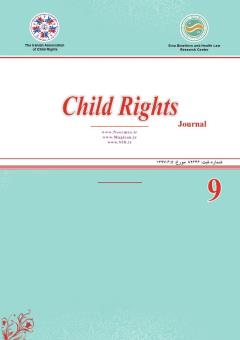The Role of Child Hyperactivity Disorder in Adult Crime
Subject Areas : حقوق کودک
1 - Department of Crime And Criminology Law, Faculty of Law and Political Science, Allameh Tabatabai University, Tehran, Iran
Keywords: Psychiatric Disorder, Hyperactivity, Attention Deficit Disorder, Crime, Prevention ,
Abstract :
Background and Aim: ADHD (Attention Deficit Hyperactive Disorder) is one of the common childhood disorders that can be caused by various factors. If this disorder is not diagnosed and treated on time, it can continue until adulthood and have various consequences for the person. In this article, the relationship between hyperactivity disorder and crime is investigated. Method: This descriptive study was conducted by examining various library sources and interviewing psychologists of exceptional children and social workers of the children's court. Results: As a result of the studies that were done, it can be said that hyperactive children are always at risk of committing crimes due to their inability to voluntarily inhibit their behavior. Lack of timely intervention to treat and solve the problems of children suffering from this disorder causes the transfer of these problems to adulthood, which can lead to increase and continuation of high-risk behaviors and other disorders. Conclusion: Among the different methods of crime prevention, it seems that social prevention and especially developmental crime prevention are effective in preventing children with hyperactivity from committing crimes in the future.
1. Alizadeh H. Attention Deficit, Hyperactivity Disorder. Tehran: Danzhe publications; 2009. [Persian]
2. Raven T. Hyperactive Superpower. Translated by the experts Publication. Tehran: the experts publications; 2021.
3. Kakavand A. Attention Deficit- Hyperactivity Disorder. Tehran. SarAfraz; 2009. [Persian]
4. Sharifi darAmadi P. Moradi H. Child pathological psychology. Tehran: Avaye noor; 2012. [Persian]
5. Savolainen J, Hurtig TM, Ebeling HE, Moilanen IK, Hughes LA, Taanila AM. Attention deficit hyperactivity disorder (ADHD) and criminal behaviour: the role of adolescent marginalization. European Journal of Criminology. 2010; 7(6): 442-59.
6. Young S, Thome J, ADHD and offenders. US National Library of Medicine National Institutes of Health; 2011.
7. Salehpoor GH, Pasandideh MM, Salehpoor GH. Perceived Stress and Attention Deficit Hyperactivity in Thieves and Normal Peoples. Journal of Police Medicine. 2017; 6(3): 197-205. [Persian]
8. KarAhmadi M, Tabaeeyan SR, AfkhamiAghda M. Comparison of parental interaction patterns in children with attention deficit hyperactivity disorder with the control group. Journal of Shahid Sadoughi University of Medical Sciences of Yazd. 2008; 15(1): 44-48. [Persian]
9. Kordloo M, Esmaili Z, Azadi E. Hyperactivity: Optimal strategies for interacting with hyperactive children. Journal of Exceptional education. 2013; 4: 38-48. [Persian]
10. Najafi Abrandabadi A. Criminology course lectures. Tehran University; 2002. [Persian]
11. Mirkhalili SA. The development of cities and the necessity of situational prevention of crime. Journal of Private Law Studies. 2009; 38(3): 297-316. [Persian]
12. Rayjian Asli M. A new approach to the theoretical foundations of crime prevention. Legal Journal of Justice. 2004; 68(48-49): 123-168. [Persian]
13. Abachi M. Prevention of delinquency and victimization of children. Legal Journal of Justice. 2004; 68(47): 49-86. [Persian]


